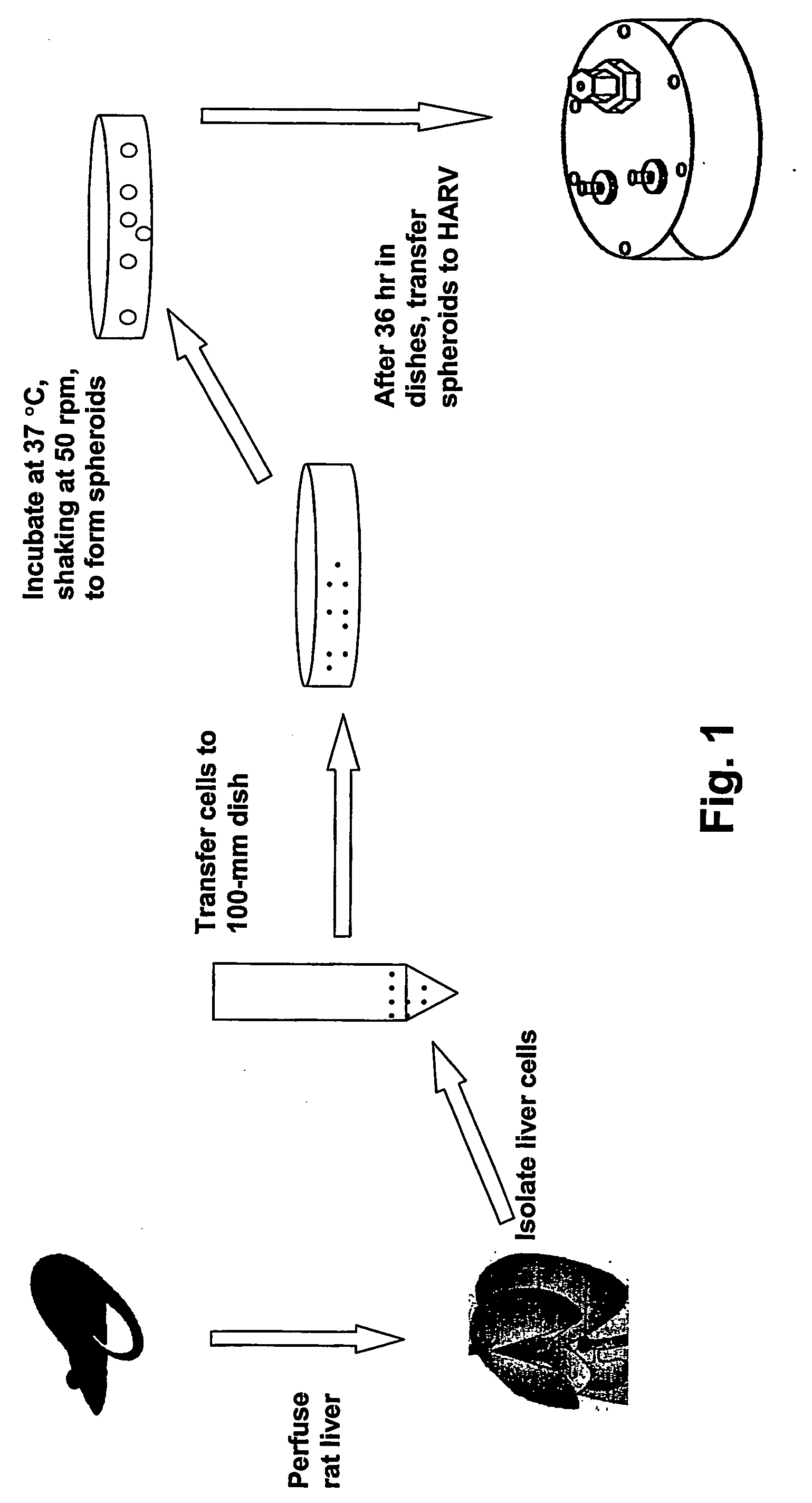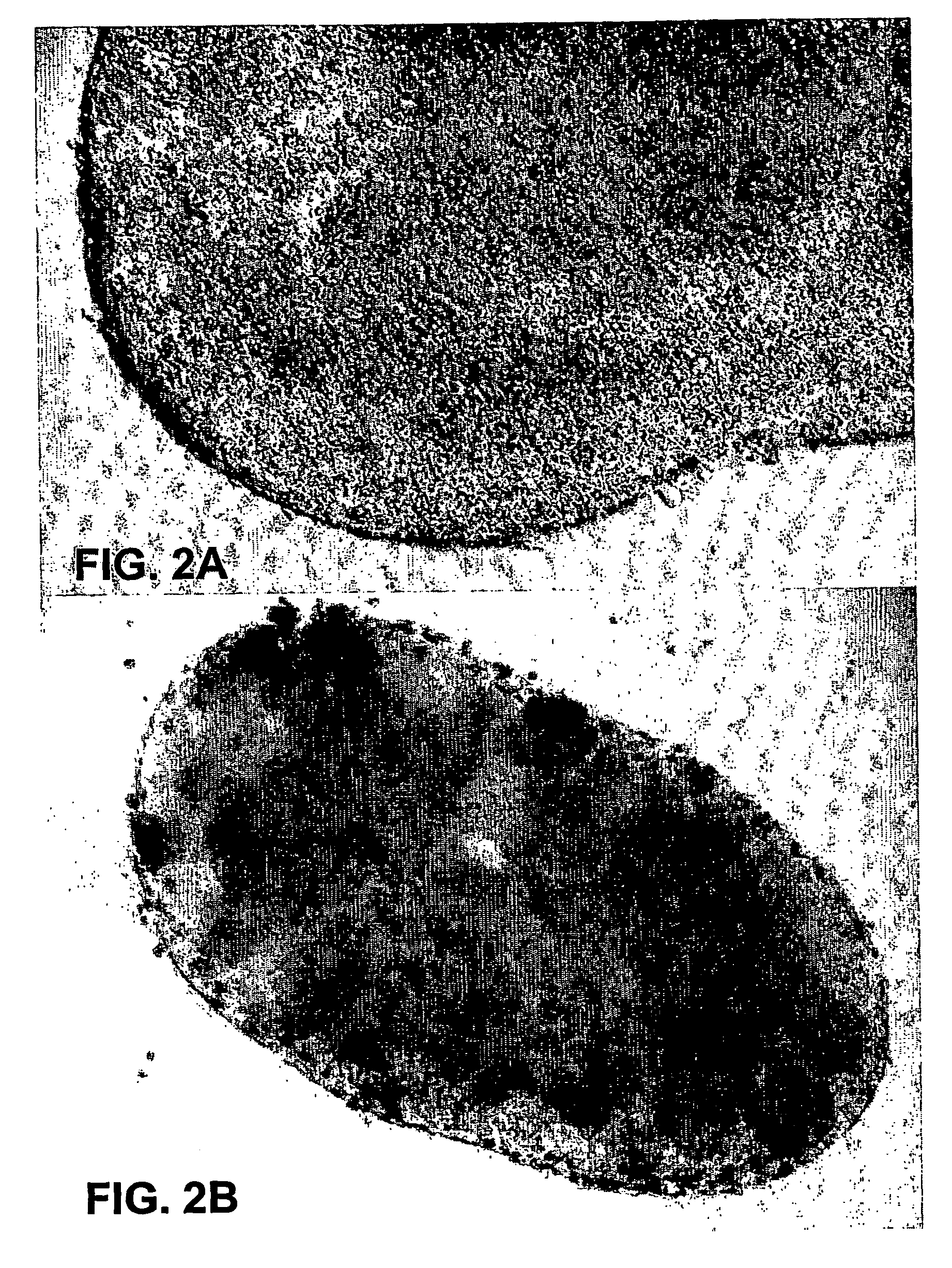Hepatocyte bioreactor system for long term culture of functional hepatocyte spheroids
- Summary
- Abstract
- Description
- Claims
- Application Information
AI Technical Summary
Benefits of technology
Problems solved by technology
Method used
Image
Examples
example i
Cell Viability and Morphology
[0104] As shown in FIG. 2A-2B, HARV cultures of hepatocyte spheroids produce even larger spheroid aggregates with high viability. The inventors examined the relative sizes of spheroids cultured in HARVs versus those cultured in Petri dishes. From 50 random measurements, the average HARV spheroids were 2.3 times larger than dish spheroids. Only a small number of peripheral cells are non-viable, as shown in FIG. 2A-2B by their uptake of trypan blue stain (seen as black spots in these photos). Also visible under the microscope is tan to brown pigmentation in the cells (seen here as dark gray patches), presumably reflecting the presence of the bile pigment bilirubin. In the present inventors' experience, such pigmentation is correlated with spheroid viability. Transmission electron micrographs of cultures according to this invention show characteristics of hepatocytes that are seen in vivo.
[0105] In particular, FIG. 3 shows copious rough endoplasmic reticu...
example ii
Long-Term Maintenance of Hepatocytes
[0106]FIG. 2 shows evidence of the capability of the present bioreactor and culture system to maintain hepatocyte viability for several weeks. Hepatocyte spheroids have been viably maintained, with activity of liver enzymes preserved, for over one month. This distinguishes the present invention from all other in vitro systems for simulating metabolism of a live mammal with an intact liver.
[0107] The first example of preservation of enzyme activity is shown in Table 1. Here, the activity of the cytochrome P450 enzyme 2B1 / 2 has been measured via the Pentoxyresorufin O-dealkylation (PROD) assay on disrupted and homogenized rat hepatocytes cultured in a HARV, as dish spheroids (SP), as monolayers (ML), and compared to freshly isolated cell suspensions (FS).
[0108] Freshly isolated rat liver cells exhibited a PROD activity of approximately 50 pmol / mg protein. Cells from this same isolation were maintained as monolayer, dish spheroid, and HARV spheroi...
example iii
Whole-Cell Drug Metabolism
[0110] It is well known in the art that many of the liver-specific enzyme functions disappear following cultivation of hepatocytes in vitro. The present invention provides an important improvement over the prior art. Table 2 summarizes the metabolism of a variety of drug substrates tested on viable whole liver cells (rat and human hepatocyte cultures from HARV, spheroids cultured in Petri dishes (SP), and freshly isolated cell suspensions (FS)) using the present bioreactor system. Activity of multiple Cytochrome P450 (CYP) and Phase II conjugation enzymes was examined. Substrates were added at a concentration of 100 μM, with the exception of tolbutamide (1 mM), and 7-Hydroxycoumarin (10 μM). Activity is measured on whole live cells in culture and analyzed by HPLC of the culture medium.
TABLE 2nmoles / mg protein / 24 hrMetabolites1-day7-day1-day7-daySubstratemeasuredEnzymeFSSPSPHARVHARVTolbutamide4-OH-2B;2C450181431tolbutamideWarfarin4-OH-warfarin3A2.34313152...
PUM
 Login to View More
Login to View More Abstract
Description
Claims
Application Information
 Login to View More
Login to View More - R&D
- Intellectual Property
- Life Sciences
- Materials
- Tech Scout
- Unparalleled Data Quality
- Higher Quality Content
- 60% Fewer Hallucinations
Browse by: Latest US Patents, China's latest patents, Technical Efficacy Thesaurus, Application Domain, Technology Topic, Popular Technical Reports.
© 2025 PatSnap. All rights reserved.Legal|Privacy policy|Modern Slavery Act Transparency Statement|Sitemap|About US| Contact US: help@patsnap.com



